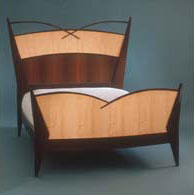
Ask any woodworking magazine or book editor to name the best colleges for furniture design, and Rhode Island School of Design (RISD) is bound to show up towards the top of the list. Made famous by the late Tage Frid, RISD has turned out some of the best in the field. Much of the credit for its current reputation has to go to Roseanne Somerson, who, for the past two decades, has taught in and run the furniture design program there.
Not surprisingly, she is also a graduate of the school, but that is just the tip of the iceberg for this extraordinarily talented and eclectic artist. Her stunning custom furniture designs start at prices upwards of $10,000, most of which make their way into museums and high end galleries. However, she designs at the other end of the spectrum as well, creating ecologically sound, highly versatile, sturdy, inexpensive furniture for college dorms. In short, she creates beautiful, practical furniture both for collectors, and for hoi polloi.
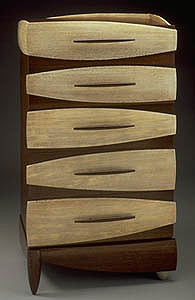
Today, Roseanne is at the very apex of her field, but the path there was not always that smooth. “I had no background in shop,” Somerson recounted. “In junior high, I tried to get into a shop course and was almost disciplined for it because it was seen as so outrageous that a woman would want to do that. The faculty sat me down and said ‘Stop this nonsense; you have to go into home economics class.’ Apparently, the shop teacher felt that I would cause a distraction. There were no other women doing it. I leaned to sew instead.”
“By the time I got to RISD, the sewing machine was the only machine I had ever used. I had to learn all about woodworking tools and equipment, the materials and structural requirements, and the esthetic requirements. Many of my peers came into the school with some of those talents already.” Interestingly, due to massive cuts in shop programs across the country, the students coming into the school today are much more like Roseanne was back then, except that they can’t even sew.
Originally, she went to RISD in 1972 to study photography, but a woodworking course set her on a different path. “I took an elective woodworking course and found it to be incredibly exciting,” Somerson said, “and the hardest thing I have ever done. I was challenged as I never had been before. I was trying to find the right means of expression, and working in three dimensions was simpatico with my needs as an artist. Plus, it was really hard work, and I like to work hard.”
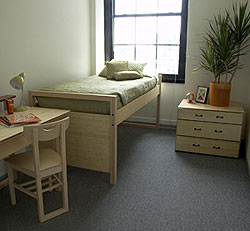
“I took as many wood classes with Tage Frid as I could, and majored in industrial design. I learned an enormous amount about technique, design, and esthetics. Then, when Frid retired, he asked me to take over his position at RISD.” She taught for a decade before expanding the program into a complete furniture design department.
In addition to teaching furniture design, she runs her own studio where she designs one-of-a-kind commission and exhibition work. “I think of furniture and objects in relation to the needs of people, and the way those objects express the culture of those people. You can define a culture accurately by looking at the furniture and objects. For example, we’ve learned a lot about the Egyptian culture by looking at the objects that came out of their tombs. We make those judgments looking back at history, but artisans are always looking forward. I try to do that with my work.”
“My studio work is very personal. The pieces are sculptural, but have the esthetic of either the space they are going in, or the needs of the client and the client’s taste, or an evolution of my own artistic expression. When I look for inspiration, I don’t look at furniture. That is a sure-fire way to recreate derivative pieces. I like to look outdoors at the natural landscape for inspiration, and even at the structure of interpersonal relationships.”
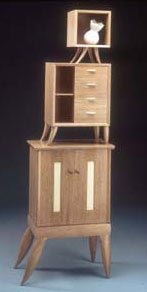
Her work covers a wide range of design, but is sensuous and invites interaction. “When someone opens a drawer, it should be like no other drawer they have ever opened,” Roseanne explained. “There must be a high level of quality throughout. Ultimately I want to make things that are very beautiful, and have a positive influence on their owners’ lives every day. Objects play a big role in the havens people create in which they live. I want my furniture to be positive part of that.”
Her latest venture, designing green and utilitarian pieces, follows the same guidelines, and then some. “In the past year I started a small company along with two colleagues in order to do some work in large scale production. We designed a line of college dormitory furniture, and five hundred rooms of it are now at RISD. It is the first green line of dorm furniture. All materials come from sustainable, ecologically sound sources. For instance, instead of using MDF and vinyl edging, we used bamboo plywood, solid wood from a certified forest, and pressboard made using nontoxic binders.”
“If I have something out in large scale, I want it to have a positive impact on the environment,” Roseanne pointed out, “not a negative one. My hope is that this could be a groundbreaking line that would generate a lot of raised awareness about the issues of green design.” But being green is hardly the only characteristic. The furniture is also extremely durable and low-cost, but still addresses the needs of students. “For example,” Roseanne said, “many students like to loft their beds. Most adjustable bed hardware is ugly and expensive. Instead, we came up with a bed that flips over so that in one mode it is in low position, and in the other it is raised, or lofted.”
The chairs they designed also break new ground. “We found that sitting in a chair with a concave seat, the most common configuration, is uncomfortable for long term sitting, and encourages slouching. One with a slightly convex seat, like ours, is both more comfortable and healthier. We also added a rack on the bottom that stores a laptop computer.”
Though they seem widely divergent, her high priced and low priced designs feed each other. “I try to bring a sensibility of designing and making things into both practices. I am always concerned with appropriate use of materials to accentuate their natural properties, developing beautiful form, and the user’s tactile experience. I want my furniture to be touched, so I think about the forms and how they relate to the hand and body. Composition and form are very important.”
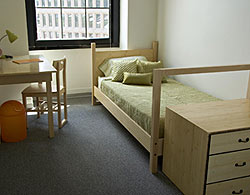
It came as no surprise to me that Somerson has received dozens of awards and prizes for her work, and that her pieces are in collections everywhere. She’s also in high demand as a judge at woodworking shows, but she has always taken time to teach others. Over the years, she has written several hundred magazine articles and sections of books, and spent time as a woodworking magazine editor as well.
“I found that working in my studio became very self indulgent, and felt I wanted to give something back to the next generation. That is why I teach. I could make a living completely from my studio, but it is really important for me to contribute to the overall scholarship and progress of the furniture field.”
What, then, does she tell her students? “I encourage people to develop their furniture ideas from a personal place” she advises. “Don’t separate craft from personal expression.”





